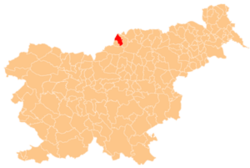Stadion na Prevaljah
|
Prevalje Občina Prevalje |
|
|---|---|
| Town and Municipality | |
 Location of the Municipality of Prevalje in Slovenia |
|
| Location of the Town of Prevalje in Slovenia | |
| Coordinates: 46°32′48″N 14°58′48″E / 46.54667°N 14.98000°ECoordinates: 46°32′48″N 14°58′48″E / 46.54667°N 14.98000°E | |
| Country |
|
| Area | |
| • Total | 58.1 km2 (22.4 sq mi) |
| Population (2002) | |
| • Total | 6,643 |
| • Density | 110/km2 (300/sq mi) |
| Time zone | CET (UTC+01) |
| • Summer (DST) | CEST (UTC+02) |
Prevalje (pronounced [ˈpɾeːʋaljɛ]; German: Prävali) is a settlement and a municipality in northern Slovenia. It lies in the traditional Slovenian province of Carinthia. On 1 January 1999 Prevalje became an independent municipality. Prevalje lies in a valley where the Meža River emerges from a narrow gorge, full of fluvioglacial sediments. To the north the settlement is limited by the Strojna, Stražišče, and Dolga Brda hills. To the south are Navrski vrh (605 m) and Riflov vrh (726 m).
The area around Prevalje was settled in prehistoric times, attested by archeological finds which include a bronze axe of the Hallstatt culture. In 1860, approximately 50 Roman marble slabs were found in the riverbed below today's cellulose and cardboard factory at Paloma in Zagrad. The stones belonged to a large tomb on the Roman road from Celeia to Virunum. At the nearby Brančurnik pub, a Roman sarcophagus known as the Brančurnik Bench (Slovene: Brančurnikova klop) can be seen.
One of the last battles of the Second World War in Europe, the Battle of Poljana, was fought nearby on 14 and 15 May 1945 between the Yugoslav army and retreating Axis forces. In 2010, Slovenian officials discovered a mass grave containing the remains of approximately 700 men and women killed by units of KNOJ in 1945.
The historical center of Prevalje is on the left bank of the Meža, on the north edge of the valley, in the hamlet of Na Fari around the parish church dedicated to the Assumption of Mary, known locally as Mary on the Lake (Slovene: Marija na jezeru). It was originally a late Romanesque building, first mentioned in written documents dating to 1335, but the current church dates to 1890. A second historical centre lies around the confluence of Leše Creek (Slovene: Leški potok) with the Meža. This is where the first industrial companies were established at the beginning of the 18th century, laying the foundations for rapid economic development of the area.
...
Wikipedia

